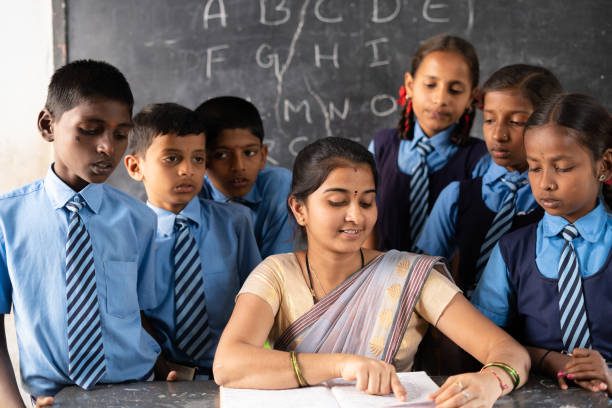With over 250 million school-going students, India is one of the largest hubs for education and training. Nearly 1.49 Million schools and 4.9 million teachers are available at present in India. A substantial youth population, including 580 million people within the age bracket of 5-24 years, meets the demand for a highly skilled and efficient workforce in the education industry in India.
However, just looking at a few numbers, it is difficult to understand the complete scenario of the Indian education sector. So, here is the blog. In this blog, we will discuss the details of the education industry in India. The numbers, facts and all other details will be mentioned here. Let’s proceed.
The Impact of National Education Policy 2020 on the Education Industry in India
The government’s implementation of the National Education Policy 2020 is a significant incident in the Indian education system. The NEP strongly focuses on curricular changes to build strong foundational skills, primarily focusing on students’ holistic development.
Moreover, it envisions making our country, India, a preferred destination for higher education. Thus, the policy promotes internationalization by fostering diverse collaborations and exchange programs between Indian and foreign institutions.
The Market Size of the Education Industry in India
Despite your passion for learning and teaching, you might not be aware of these numbers related to the Indian education sector. According to an IBEF report, India has more than 250 million school-going students. Also, it had 38.5 million students enrolled in higher education in 2019-20, with a ratio of 19.6 million male and 18.9 million female students.
As per UNESCO’s ‘State of the Education Report for India 2021’, the Pupil Teacher Ratio (PTR) at senior secondary schools was 47:1, as against 26:1 in the overall school system.
Higher education in India also has a broad sub-sector under the education industry in India. The number of colleges in India reached 49,385 in FY24 (as of September 13, 2023) and 43,796 in FY21, which is up from 42,343 in FY20. Also, the number of Indian universities reached 1,196 in FY24 (as of September 13, 2023), which is up from 760 in FY15.
Factors that Drive Growth in the Indian Education Sector
The growth in the education industry in India is prominent. But what are the major factors to drive that growth? Let’s see them here.
Government Initiatives
Favourable Government policies like The National Education Policy (NEP) 2020, Sarva Shiksha Abhiyaan, Rashtriya Ucchatar Shiksha Abhiyan and other programs to transform the Indian education system to meet the needs of the 21st Century. The UGC, or University Grants Commission of India, approved regulations for foreign collaboration to offer joint, dual, or twinning programs in April 2022. Also, the commission announced Draft Regulations 2023 to allow foreign universities to set up physical campuses in India.
Robust Technology Infrastructure
Although, some areas have not got the facility of technology yet, India is a large hub for technology infrastructure. India has 2nd largest Internet user market with 820+ million users. Simply put, technology infrastructure, with high-speed internet and widespread use of smartphones, creates a favorable environment for technology-based educational solutions.
Large Population
This is always a benefit for the education industry in India. This allows easy delivery of educational products. Moreover, India has a significant number of English-speaking population. The country was ranked 52nd out of 111 countries in the English Proficiency Index 2022. So, circulating educational services becomes easy.

IFSC GIFT City
It is another important factor that drives growth in the Indian education sector. IFSC GIFT city allows the setting up of offshore centers for foreign universities in India.
With all these factors helping the industry to grow, the Indian education sector shapes human capital and plays a pivotal role in driving economic growth. Thus, it contributes significantly to India’s GDP, reflecting its importance in the nation’s overall development agenda.
Final Thoughts
In the long run, the education industry in India stands as an epitome of growth and innovation. Also, it leaves a strong impact on the nation’s socio-economic structure. While it grapples with access, quality, and affordability challenges, the sector is also full of opportunities for innovation and inclusive development. By harnessing the collective efforts of stakeholders, leveraging technology, and prioritizing quality and equity, India can unlock the full potential of its education industry, paving the way for a brighter and more prosperous future.
FAQs
1. How big is the education industry in India?
With over 250 million school-going students and thousands of colleges and universities, the education industry in India is a significant sector. According to the IBEF report, the education sector in India is expected to reach US$ 225 billion by FY25.
2. What is the future outlook of the education industry in India?
The education sector in India strongly depends on the higher education segment. The Indian higher education market is expected to witness a commendable CAGR of 8.46% between 2024 and 2032.
3. What is the biggest problem in the education sector in India?
Infrastructure disparity is a crucial issue in the education sector in India. The differences between urban and rural places in terms of access to quality education disturb the whole infrastructure of the education sector in India.
4. Which state is rich in education in India?
When it comes to education, it is difficult to name only one state in India. However, some of the top educated states in India include Kerala, Maharastra, West Bengal, Tripura, Delhi, Himachal Pradesh, Puducherry, etc.

Comments 0